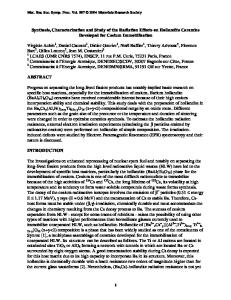Radiation Effects in Ceramics
- PDF / 811,690 Bytes
- 7 Pages / 576 x 777.6 pts Page_size
- 67 Downloads / 391 Views
Optical Properties Neutron irradiation has been widely used to produce point defects (color centers) in a wide range of oxide materials 22
that are optically transparent in singlecrystal form. Although energetic electrons and ions are capable of producing the same defects, these irradiating particles have a limited range, usually less than 1 mm, in contrast to the range of fast neutrons of the order of centimeters. Ion-beam irradiation also has a characteristic in which the impinging ion, when it comes to rest in the solid, can chemically affect the behavior of defects that survive. For example, ion irradiation of sapphire has the apparent effect of suppressing the formation of oxygen vacancies when self-irradiated with oxygen ions and of enhancing their formation when self-irradiated with aluminum ions. Early studies of radiation-induced point defects in oxides concentrated mainly on MgO and CaO, which were readily available as reasonably pure single crystals. These materials have the
100 —10 1 8 n/cm 2 (E n >1 MeV) — x-irradiated to 3 x 104 Gy • Unirradiated
0.1
0.01
200 300 400 500 600 700 800 900 Wavelength (nm)
Figure 1. Optical absorption spectrum of sapphire neutron-irradiated at 300°C compared with the unirradiated and x-irradiated spectra.
face-centered-cubic rock-salt structure, and their binding is primarily ionic. Electrons trapped at defect sites generally have energies between the valence band and the empty conduction band. As a result, optical or magnetic resonance spectroscopy is possible. Vacancies in these materials may occur on both anion and cation sublattices. The anion vacancy may trap one or two electrons, in which case they are known as F + or F centers, respectively. The F center is uncharged with respect to the lattice. An aggregate of single point defects is specified by a number subscript—for example, three adjacent F centers are labeled F3 and would have the same charge as the perfect lattice. If the charge is different, then a superscript would indicate this condition. Vacancies on the cation sublattice are designated by the letter V. In this case, electrical neutrality is maintained by neighboring ions with the same number of electron holes as the charge of the missing lattice ion. If charge neutrality is not maintained, then this is again indicated by a superscript— for example the V center would have two holes shared by oxygen ions surrounding the cation vacancy, while the V center would have only one hole. A comprehensive compendium of defect nomenclature appears in work by Bridges et al.2 In neutron and heavy ion irradiations, collision events produce cascades of displacements in a sufficiently small volume to generate a significant concentration of surviving near-neighbor point defects. Di- and tri-defect aggregates can also be produced by migration of point defects during annealing. At higher fluences, interstitials can aggregate into dislocation loops visible in the electron microscope. Neutron irradiation is not a particularly efficient damage process; Henderson and Kin
Data Loading...











